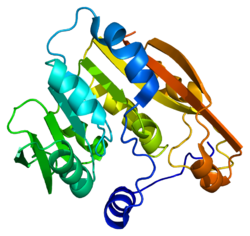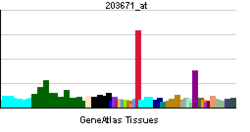|
硫嘌呤甲基转移酶
硫嘌呤甲基转移酶(英語:Thiopurine methyltransferase或Thiopurine S-methyltransferase,EC 2.1.1.67),又称巯基嘌呤甲基转移酶或巯嘌呤甲基转移酶,简称TPMT,是一种催化硫嘌呤类化合物甲基化的酶。硫嘌呤类药物常用于癌症化学疗法及免疫抑制疗法,因而TPMT的活性会影响使用这类药物时不同患者对药物的敏感性和毒性反应。[1][2] 药理学TPMT是硫嘌呤类药物(如硫唑嘌呤、巯嘌呤和硫鸟嘌呤)的代谢中最主要的酶之一,起到的作用是在这类化合物的硫原子上增加一个甲基;这个过程中提供甲基的是S-腺苷甲硫氨酸,后者同时被转化成S-腺苷-L-高半胱氨酸。[4] TPMT基因的缺陷会让人体无法将这类药物灭活,未代谢的药物因此在体内大量累积,从而引起严重甚至致命的骨髓抑制,表现为贫血、血小板减少症(导致出血)和白细胞减少症(导致感染)等。[2][5] 临床意义研究显示,临床上大约5%的硫嘌呤类药物疗法由于毒性原因而终止。[6] 一般来说,在使用硫嘌呤类药物前及治疗过程中会多次测量病人的TPMT酶活性,以防止TPMT不活跃者(占总人口约10%)及TPMT无活性者(占总人口约0.3%)在使用这类药物后产生的严重骨髓毒性。[4] 近年来也开始采用基因测试,相对于前者优点在于测试不需要反复进行。[7] 参考资料
|
||||||||||||||||||||||||||||||||||||||||||||||||||||||||||||||||||||||||||||||||||||||||||
Index:
pl ar de en es fr it arz nl ja pt ceb sv uk vi war zh ru af ast az bg zh-min-nan bn be ca cs cy da et el eo eu fa gl ko hi hr id he ka la lv lt hu mk ms min no nn ce uz kk ro simple sk sl sr sh fi ta tt th tg azb tr ur zh-yue hy my ace als am an hyw ban bjn map-bms ba be-tarask bcl bpy bar bs br cv nv eml hif fo fy ga gd gu hak ha hsb io ig ilo ia ie os is jv kn ht ku ckb ky mrj lb lij li lmo mai mg ml zh-classical mr xmf mzn cdo mn nap new ne frr oc mhr or as pa pnb ps pms nds crh qu sa sah sco sq scn si sd szl su sw tl shn te bug vec vo wa wuu yi yo diq bat-smg zu lad kbd ang smn ab roa-rup frp arc gn av ay bh bi bo bxr cbk-zam co za dag ary se pdc dv dsb myv ext fur gv gag inh ki glk gan guw xal haw rw kbp pam csb kw km kv koi kg gom ks gcr lo lbe ltg lez nia ln jbo lg mt mi tw mwl mdf mnw nqo fj nah na nds-nl nrm nov om pi pag pap pfl pcd krc kaa ksh rm rue sm sat sc trv stq nso sn cu so srn kab roa-tara tet tpi to chr tum tk tyv udm ug vep fiu-vro vls wo xh zea ty ak bm ch ny ee ff got iu ik kl mad cr pih ami pwn pnt dz rmy rn sg st tn ss ti din chy ts kcg ve




